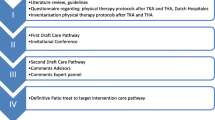Abstract
Background
Fast track rehabilitation after primary total hip (THR) and total knee replacement (TKR) is gaining popularity. We performed a prospective clinical trial to identify predictive factors for successful fast track rehabilitation.
Methods
Between June 2005 and January 2006, 52 THR and 48 TKR were performed on consecutive patients off the local waiting list with no pre-selection or exclusion criteria. Patients underwent a fast track rehabilitation programme within a group-dynamic set-up aiming for discharge day 3 to 5 postoperatively. Demographic, clinical and social factors were analysed.
Results
Eighty-four percent (n = 44) of THR patients and 73% (n = 35) following TKR achieved the target discharge. Average discharge after THR was 5.4 and 5.5 days after TKR. Delayed discharge was mostly related to medical, social and organisational reasons. Age, 3 m-get-up-and-go-test (3 m-TGUGT), home situation and preoperative walking distance were the main predictors for the early discharge after THR; age, diagnosis, ASA class and preoperative pain medication were influential for TKR. Perioperative complication rates were within or below the national average.
Conclusion
Successful fast track rehabilitation is possible without pre-selection and does not seem to compromise clinical safety. However, a good social and physiotherapy community set-up should be available. The identified predictive factors could be helpful to identify candidates for fast track rehabilitation.
Similar content being viewed by others
References
Coventry M, Beckenbaugh R, Nolan D, Ilstrup D (1974) 2, 012 total hip arthroplasties: a study of post-operative course and early complications. J Bone Joint Surg Am 56:273–284
Harris WH, Sledge CB (1990) Total hip and knee replacement. N Engl J Med 323:801–807
House of Commons report 2003–2004: hip replacements: an update. 17th report of session 2003–2004, pp 12–13
Scottish Arthroplasty Project Annual Report (2008) Appendix 8: pp 14-17
DiGioia AMIII, Plakseychuk AY, Levison TJ, Jaramaz B (2003) Mini-incision for total hip arthroplasty with navigation. J Arthroplast 18(2):123–128. doi:10.1054/arth.2003.50025
Berger RA (2004) Mini-incision total hip replacement using an anterolateral approach. Technique and results. Orthop Clin North Am 35:143–151. doi:10.1016/S0030-5898(03)00111-1
Berger RA, Jacobs JJ, Meneghini RM, Della Valle C, Paprosky W, Rosenberg AG (2004) Rapid rehabilitation and recovery with minimally invasive total hip arthroplasty. Clin Orthop Relat Res 429:239–247. doi:10.1097/01.blo.0000150127.80647.80
Munin M, Kwoh K, Glynn N, Crosett L, Rubash HE (1995) Predicting discharge outcome after elective hip and knee arthroplasty. Am J Phys Med Rehabil 74:294–301. doi:10.1097/00002060-199507000-00006
Forrest G, Fuchs M, Gutierrez A, Girardy J (1998) Factors affecting length of stay and need for rehabilitation after hip and knee arthroplasty. J Arthroplast 13:186–190. doi:10.1016/S0883-5403(98)90097-3
O’Brien S, Ogonda L, Dennison J, Doran E, Lawlor M, Humphreys P, Kelly P, Matthews L, Beverland D (2005) Day two post operative ‘fast track’ discharge following primary total hip replacement. J Orthop Nurs 9:140–145. doi:10.1016/j.joon.2005.05.002
Harris WH (1969) Traumatic arthritis of the hip after dislocation and acetabular fractures: treatment by mold arthroplasty. An end-result study using a new method of result evaluation. J Bone Joint Surg Am 51:737–755
Dawson J, Fitzpatrick R, Carr A, Murray D (1996) Questionnaire on the perceptions of patients about total hip replacement. J Bone Joint Surg Br 78:185–190
Dawson J, Fitzpatrick R, Murray D, Carr A (1998) Questionnaire on the perceptions of patients about total knee replacement. J Bone Joint Surg Br 80:63–69. doi:10.1302/0301-620X.80B1.7859
Insall JN, Dorr LD, Scott RD, Scott WN (1989) Rationale of the knee society clinical rating system. Clin Orthop Relat Res 248:13–14
Mathias S, Nayak U, Isaacs M (1986) Balance in elderly patients: the ‘get-up and go-test’. Arch Phys Med Rehabil 67:387–389
Taylor LJ, Singh G, Schneider M (2005) Outcome with a tapered, polished, anatomic stem. In: Breusch SJ, Malchau H (eds) The well-cemented total hip arhroplasty: theory and practice. Springer, Heidelberg, pp 242–248
Ogonda L, Wilson R, Archbold P, Lawlor M, Humphreys P, O’Brien S, Beverland D (2005) A minimal-incision tecnique in total hip arthroplasty does not improve early postoperative outcomes. J Bone Joint Surg Am 87:701–710. doi:10.2106/JBJS.D.02645
Woolson ST, Mow CS, Syquia JF, Lannin JV, Schurman DJ (2004) Comparison of primary total hip replacements performed with a standard incision or a mini-incision. J Bone Joint Surg Am 86:1353–1358
Amin AK, Patton JT, Cook RE, Brenkel IJ (2006) Does obesity influence the clinical outcome at 5 years following total knee replacement for osteoarthritis? J Bone Joint Surg Br 88:335–340. doi:10.1302/0301-620X.88B3.16488
Davis AM, Agnidis Z, Badley E, Kiss A, Waddell JP, Gross AE (2006) Predictors of functional outcome 2 years following revision hip arthroplasty. J Bone Joint Surg Am 88:685–690. doi:10.2106/JBJS.E.00150
SooHoo NF, Lieberman JR, Ko CY, Zingmond DS (2006) Factors predicting complication rates following total knee replacement. J Bone Joint Surg Am 88:480–485. doi:10.2106/JBJS.E.00629
Lingard EA, Sledge CB, Learmonth ID (2006) Patient expectations regarding total knee arthroplasty: differences among the United States, United Kingdom and Australia. J Bone Joint Surg Am 88:1201–1207. doi:10.2106/JBJS.E.00147
Husted H, Hansen HC, Holm G, Bach-Dal C, Rud K, Andersen KL, Kehlet H (2006) Accelerated versus conventional hospital stay in total hip and knee arthroplasty III: patient satisfaction. Ugeskr Laeger 168(22):2148–2151
Kim S, Losina E, Solomon DH, Wright J, Katz JN (2003) Effectiveness of clinical pathways for total knee and total hip arthroplasty. J Arthroplast 18(1):69–74. doi:10.1054/arth.2003.50030
Author information
Authors and Affiliations
Corresponding author
Rights and permissions
About this article
Cite this article
Schneider, M., Kawahara, I., Ballantyne, G. et al. Predictive factors influencing fast track rehabilitation following primary total hip and knee arthroplasty. Arch Orthop Trauma Surg 129, 1585–1591 (2009). https://doi.org/10.1007/s00402-009-0825-9
Received:
Published:
Issue Date:
DOI: https://doi.org/10.1007/s00402-009-0825-9




